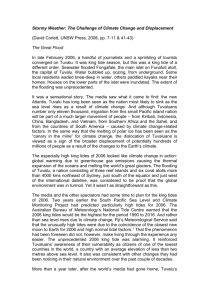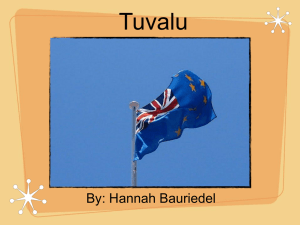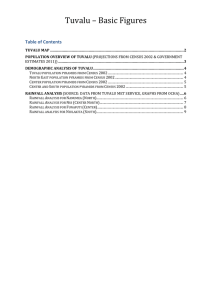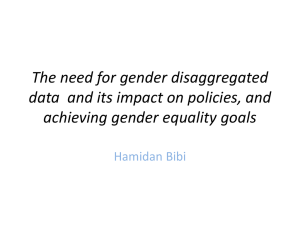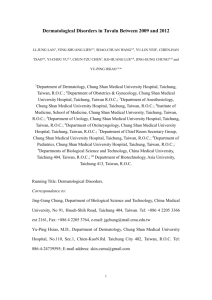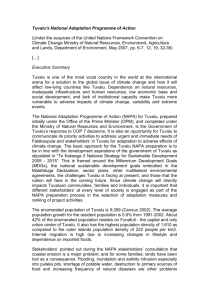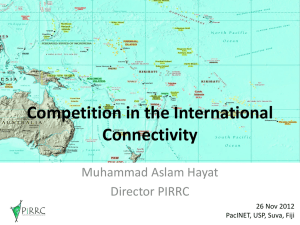Tuvalu-Islanders-Lose-Ground-to-Rising-Sea
advertisement
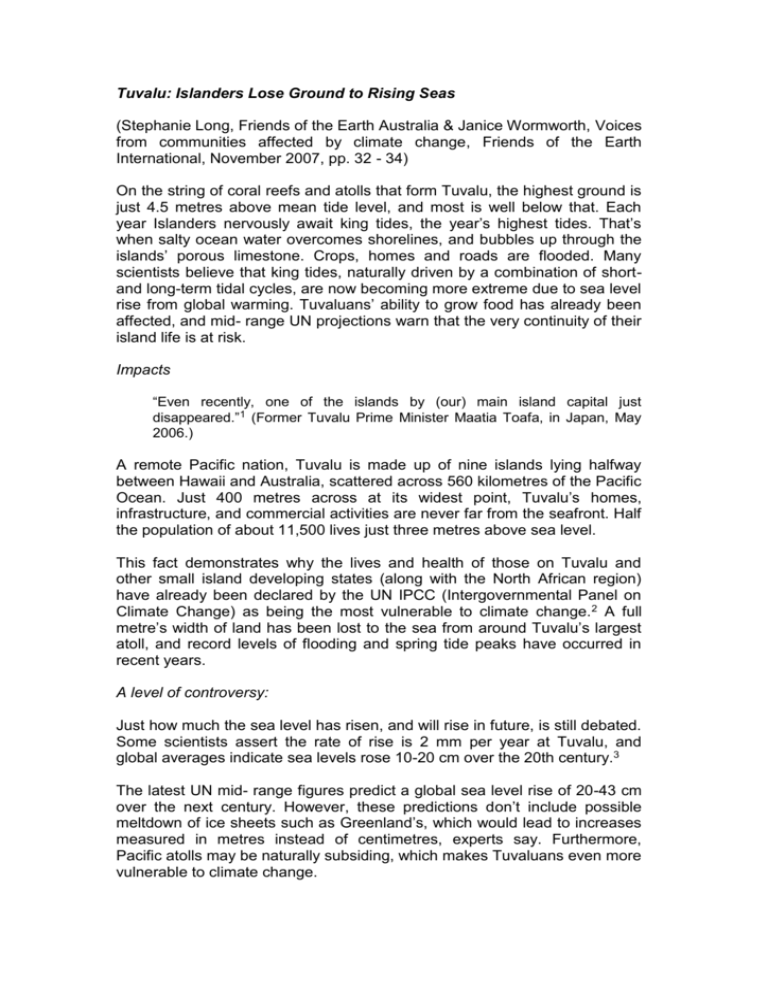
Tuvalu: Islanders Lose Ground to Rising Seas (Stephanie Long, Friends of the Earth Australia & Janice Wormworth, Voices from communities affected by climate change, Friends of the Earth International, November 2007, pp. 32 - 34) On the string of coral reefs and atolls that form Tuvalu, the highest ground is just 4.5 metres above mean tide level, and most is well below that. Each year Islanders nervously await king tides, the year’s highest tides. That’s when salty ocean water overcomes shorelines, and bubbles up through the islands’ porous limestone. Crops, homes and roads are flooded. Many scientists believe that king tides, naturally driven by a combination of shortand long-term tidal cycles, are now becoming more extreme due to sea level rise from global warming. Tuvaluans’ ability to grow food has already been affected, and mid- range UN projections warn that the very continuity of their island life is at risk. Impacts “Even recently, one of the islands by (our) main island capital just disappeared.”1 (Former Tuvalu Prime Minister Maatia Toafa, in Japan, May 2006.) A remote Pacific nation, Tuvalu is made up of nine islands lying halfway between Hawaii and Australia, scattered across 560 kilometres of the Pacific Ocean. Just 400 metres across at its widest point, Tuvalu’s homes, infrastructure, and commercial activities are never far from the seafront. Half the population of about 11,500 lives just three metres above sea level. This fact demonstrates why the lives and health of those on Tuvalu and other small island developing states (along with the North African region) have already been declared by the UN IPCC (Intergovernmental Panel on Climate Change) as being the most vulnerable to climate change. 2 A full metre’s width of land has been lost to the sea from around Tuvalu’s largest atoll, and record levels of flooding and spring tide peaks have occurred in recent years. A level of controversy: Just how much the sea level has risen, and will rise in future, is still debated. Some scientists assert the rate of rise is 2 mm per year at Tuvalu, and global averages indicate sea levels rose 10-20 cm over the 20th century.3 The latest UN mid- range figures predict a global sea level rise of 20-43 cm over the next century. However, these predictions don’t include possible meltdown of ice sheets such as Greenland’s, which would lead to increases measured in metres instead of centimetres, experts say. Furthermore, Pacific atolls may be naturally subsiding, which makes Tuvaluans even more vulnerable to climate change. Fragile foundation: The coral that forms Tuvalu’s reefs and atolls (ring-shaped coral islands enclosing lagoons) provides natural breakwaters that shield shorelines from waves and storm surges. Coral reefs also provide habitat for fish and wetlands. Yet coral’s vulnerability to climate change is another concern in Tuvalu, where the coral grows relatively slowly and likely won’t keep up with sea level rise. Nor will coral tolerate changes in water surface temperature or rising ocean CO2 levels.4 Cyclone danger: Tuvalu is also located near the cyclone belt.5 “We are already experiencing increased frequency of cyclones, tornados, flooding, and tide surges many of which unexpectedly hit us outside the usual climatic seasons of the islands,”6 Tuvalu’s former Prime Minister told the UN in 1997. Sea level rise coupled with increased cyclone activity threatens extreme flooding events. Islanders have not forgotten 1972 Cyclone Bebe, which left 800 homeless. Siuila Toloa, teacher, former Tuvalu Red Cross secretary, and board member of Island Care, a Tuvalu environmental group. On the global politics of climate change: Countries are denying the fact that it is our business to address climate change. I say it is OUR business. Tuvalu is a small country. We are looking at facing a big problem there ... We can barely save our people’s lives if the story comes true and Tuvalu is sinking. ... The small island states contribute insignificantly to global emissions, but suffer most. On the prospect of Tuvaluans becoming climate refugees: Climate change is an environmental issue that leads to the complete obliteration of Tuvalu. ... Tuvaluans become climate change refugees when the land of Tuvalu becomes uninhabitable. With this last resort adaptation to climate change we Tuvaluans lose our sovereignty, our traditional customs. I think you all know how important these are to us as native landholders. On local impacts: Tuvalu lives off a subsistence income and therefore is heavily dependent on its immediate surroundings: the marine and terrestrial resources. The people are noticing a marked decline in their traditional crops and marine resource harvest. In other words, there is a decline in local food security. Once in 2003, the most amazing thing, we really don’t know why — it was just a really calm day and high waves came, affecting the coastal areas and really damaged the people’s gardens. And then frequent drought — it’s so frequent ... three months of drought, it is really bad for us. On water: The decrease in locally grown food is the product of an increase in areas that are degraded by salt water intrusion. This reduces the land’s productive capabilities. ... It has affected traditional crops of six of Tuvalu’s eight islands and it will increase. Some family residences have been affected. It has also increased ground water salinity. ... This [ground water] is the main source of potable water for Tuvalu and we have lost a valuable resource. “Moving away from Tuvalu is not good for our culture and values. We want to live in our own land, our home and where our forefathers have lived. Tuvaluan people don’t like to be called refugees.” (Annie Homasi, Coordinator, Tuvalu Association of Non-Governmental Organisations.) Freshwater is another growing concern: For many Pacific Island nations, especially atoll nations such as Tuvalu, rainwater is the major water source. An important backup is the thin layer of underground freshwater (called a freshwater “lens”) which sits atop the heavier, deeper saltwater. In Tuvalu both these freshwater resources are at risk. The El Niño Southern Oscillation (ENSO), which is expected to become more frequent and persistent, has caused droughts for Tuvalu 7, while sea level rise threatens the freshwater lens.8 Poisoned paradise: Tuvaluans have always relied on locally-grown food and fishing to meet their needs. Yet on six Tuvalu islands, rising sea level is already making some soils too salty, poisoning gardens. For example, puluka, a giant swamp plant and Tuvalu’s main source of taro, is grown in deep pits to tap the fresh water lens. Puluka cannot tolerate salt and is very vulnerable to saltwater intrusion. These problems, along with land shortages, and increased purchasing power due to employment, have led to a shift from local to imported foods. Unhealthy trends: Tuvaluans’ dietary shift from local to imported food is already associated with lifestyle diseases such as high hypertension and diabetes. Another important health risk relates to water. Malaria and dengue fever can become more prevalent with warming and flooding. Failed sewage and water systems due to flooding can also increase the prevalence of other diseases.9 Adaptation “We live in constant fear of the adverse impacts of climate change. For a coral atoll nation, sea level rise and more severe weather events loom as a growing threat to our entire population. The threat is real and serious, and is of no difference to a slow and insidious form of terrorism against us.” (Former Tuvalu Prime Minister Saufatu Sopoanga at the UN General Assembly, New York, 2003) Pacific islanders contribute little to the problem of global warming, producing only 0.03 percent of the global emissions (from burning fossil fuels), though they are home to 0.12 percent of the world’s population. 10 Yet Tuvaluans’ losses will be great indeed if international action is not taken to arrest global warming; they will ultimately be forced to abandon their homeland. Small but vocal: Thus one major Tuvalu survival strategy has been a strong presence at international climate change negotiations, starting in 1992. Though a major expense for the word’s second-smallest independent country (by population), Tuvalu joined the United Nations in 2000, to further spotlight climate change. UN membership allows Tuvalu to position itself as a conscience and to be the most vocal voice in this crucial work, with and on behalf of the Association of Small Island States. Grassroots approaches: On the home front, the strongly-Christian nation can draw on the church, which can play a major role in civil society and grassroots approaches to climate change. In terms of practical measures, so far Tuvaluans have been adapting by planting crops in buckets, rather than in the ground, as a response to saltwater intrusion. Introducing salt-tolerant crops is another logical step, one of many that scientists and government officials urge as “no-regrets” policies — those that make sense regardless of whether the seas rise. Tree-planting programs to protect beaches from erosion have been led by NGOs, and sea-walls have been constructed to protect from storm surges. Annie Homasi, Coordinator, Tuvalu Association of Non-Governmental Organisations. On local impacts: The weather changes and heat affects people, but also sea-level rise. ... My own experience is that during spring tides in March, my house concrete foundation is now half in the water. This is what I have seen and based on my own markings of the water level at my house. On global politics of climate change: The Australian government has not been willing to consider environmental refugees, and is not very friendly. New Zealand has been more flexible and a work scheme has been negotiated between New Zealand and Tuvalu. People in Tuvalu are thinking that they will need to make a move because of global warming. People living in Melbourne, Australia, who have moved there 30 or 40 years ago are very concerned about where people of Tuvalu will be able to go. Moving away from Tuvalu is not good for our culture and values. Where we live now, we know how to behave and live within our means. It will not be comfortable to live in another place. We want to live in our own land, our home and where our forefathers have lived. Tuvaluan people don’t like to be called refugees. Another no-regrets policy would be addressing local pollution caused by population growth and poor environmental management. Garbage is dumped on beach areas and in “borrow pits” dug by the US Army during WW II. Garbage and liquid waste threatens to pollute underground drinking water, and sea water, and could thus harm corals. 11 Yet another step would be to curtail beach mining which speeds up coastal erosion. Though illegal, this is done to provide material to build homes; yet construction material could be obtained in less destructive ways. Awareness projects on climate change are also needed, especially for inhabitants on outer islands who lack access to information and are less likely to speak English. “We don’t want to leave this place. We don’t want to leave, it’s our land, our God given land, it is our culture, we can’t leave. People won’t leave until the very last minute” (Former Assistant Secretary, Tuvalu Ministry of Natural Resources, Energy and Environment, Paani Laupepa.) The last resort: Climate refugees are likely to be the largest and fastest-growing category of ecologically displaced people.12 Tuvalu is the first country forced to evacuate residents because of rising sea levels; many Tuvaluans have also migrated internally, to the larger atoll of Funafuti from outer islands. The Tuvalu government has actively pursued migration options. One result is New Zealand’s Pacific Access Category programme, which accepts 75 Tuvaluans each year. Yet applicants must be of “good character and health, have basic English skills, have a job offer in New Zealand, and be under 45 years of age”.13 Tuvalu government representatives have so far met with no success in attempts to discuss immigration with Australia. Conclusion “What’s more, the people of Tuvalu want to see a positive response from you people on the issue of climate change. We need to work together as friends to address the climate change issue. To do this all developed countries must ratify the Kyoto Protocol ... If you love us, please, sign the Kyoto Protocol for Tuvalu’s sake.” (Tuvaluan teacher and environmentalist Siuila Toloa.) Climate change is a risk to environments worldwide, but on Tuvalu and other small island states, whole nations and cultures are in jeopardy. Small size and limited access to capital, technology, and human resources compound the difficulties atoll countries such as Tuvalu face in adapting to climate change. Ultimately, however, Tuvalu will be unable to adapt in the face of the relentless sea level rise and extreme weather events that would follow a global failure to curtail emissions. This fact explains the urgency with which Tuvalu’s leaders plead their case in international climate change fora. At risk is a nation’s unique culture — traditional skills, knowledge, social networks and agricultural practices that have allowed Tuvaluans to survive on their island paradise for 3,000 years. The loss of Tuvalu, possible within this century, would make our human community so much the poorer. Endnotes 1 www.planetark.com/dailynewsstory.cfm/newsid/36546/story.htm. 2 IPCC (2001): Climate Change 2001: Impacts, Adaptation, and Vulnerability. Cambridge. www.ipcc.ch/pub/reports.htm, p. 847. 3 The 7.1 million citizens in 22 Pacific island countries, including Tuvalu, are responsible for emissions of approximately 6.816 million tons of CO2 per year. www.germanwatch.org/download/klak/fb-tuv-e.pdf. 4 UNFCCC (Eds., 1999): Tuvalu Initial National Communication Under the United Nations Framework Convention of Climate Change; www.unfccc.int/resource/docs/natc/tuvnc1.pdf p.28. 5 UNFCC 1999, p. 13. 6 www.tuvaluislands.com/kyoto-panieu.htm. 7 IPCC (2001), p. 861. 8 www.foe.org.au/resources/publications/climate-justice/CitizensGuide.pdf/view. 9 IPCC (2001), p. 864. 10 IPCC (2001), p. 867. 11 UNFCCC (1999), p. 29. 12 www.foei.org/publications/pdfs/island.pdf. 13 www.germanwatch.org/download/klak/fb-tuv-e.pdf [Sources omitted]
